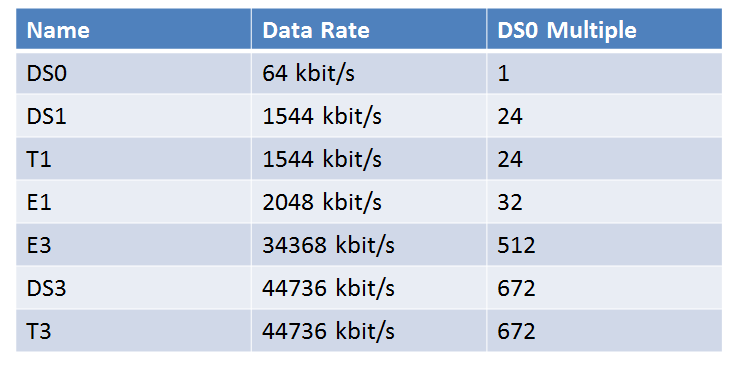I’m preparing for the CCDE practical and I was doing a practice scenario by Jeremy Filliben and I realized that I’m not comfortable with all of the WAN speeds so I might as well write a blog post on it. I was familiar with some of them like T1, E1, DS3, OC-192 etc but there are still some I could not remember. This post will describe some of the most commonly used WAN rates.
Some of the CCDE scenarios are based on that we are upgrading a network or migrating from an old network. In real life it’s likely that most service providers will already have moved to Ethernet but it makes a more interesting scenario to build a network mimicing the FRR capabilities of SDH for example.
Digital Signal 0 (DS0) is a rate that was introduced to carry a digitized single call at 64 kbits/s. A DS1 can transport 24 DS0 and runs at 1544 kbit/s. Note that 24 * 64 is 1536 but the extra 8 kbit/s is used for frame synchronization. A DS3 runs at 44736 kbit/s and can transport 28 DS1 or 672 DS0. A T3 also runs at the same rate as a DS3. The T- and E carrier systems are plesiousynchronous meaning that the are almost synchronized but not quite.
The E carrier system does not run at the same rates as the T carrier system. An E1 can transport 32 DS0 and runs at a rate of 2048 kbit/s. An E3 can carry 512 DS0 at a rate of 34368 kbit/s.
It’s also possible to buy fractional speeds where you get alotted a certain amount of timeslots. You could buy 16 DS0 timeslots on an E1 to get 1024 kbit/s.
There are also synchronous carrier systems such as Synchronous Digital Hierarchy (SDH) and Synchronous Optical NETwork (SONET) where SDH would be used in Europe and SONET in the US. The transmission rate of logical frames in SDH is referred to STM-x and for SONET is referred to STS-x. These forms of transmission can then be carried over an Optical Carrier (OC) which refers to the physical bit rate.
The table below summarizes some of the common optical rates.

The table below summarizes some of the common DS, T and E carrier rates.

Two of the common codecs for voice digitization are G.729 and G.711. G.711 uses a bit rate of 64 kbit/s so in theory you could fit 24 calls on a T1 but with Voice over IP (VoIP) there is some overhead involved in encapsulating the voice samples so the actual bit rate is 87.2 kbit/s which means that only around 17 calls would be able to use the T1 simultaneously.
The G.729 codec uses a bit rate of 8 kbit/s but the actual bit rate is 31.2 kbit/s which means that a lot of the bytes transported are overhead. It would be possible to place around 49 calls simultaneously on a T1 when G.729 is used.
The CCDE is a high level exam but it’s still expected from the designer to know of different WAN rates and how to do basic calculations to pick the correct WAN access speeds.
Since you’re mentioning DS0 in such detail, you might want to (briefly) call out that a T1 circuit, when configured as a PRI facing the telco, would actually carry 23 calls as if it were transmitting G.711 + the data channel using the remaining 64kbps. You are absolutely correct that over a data T1 circuit that only 17xG.711 calls would be possible.
Great article, thanks!